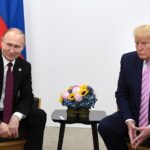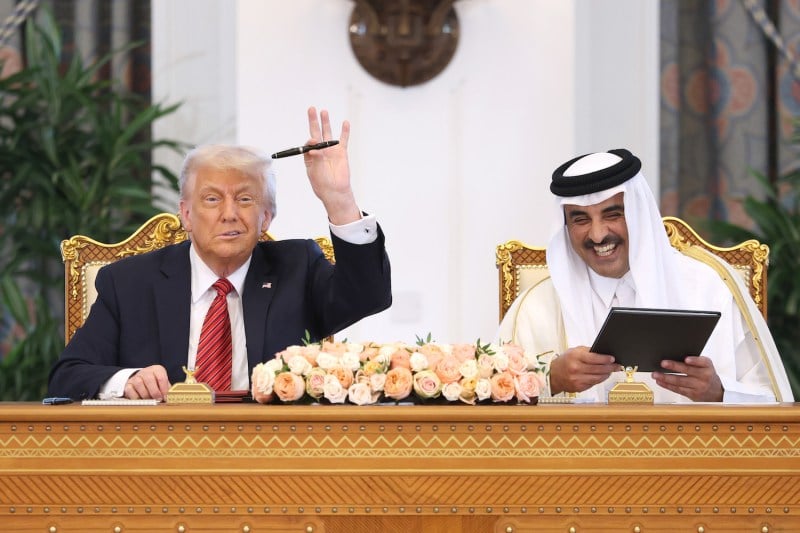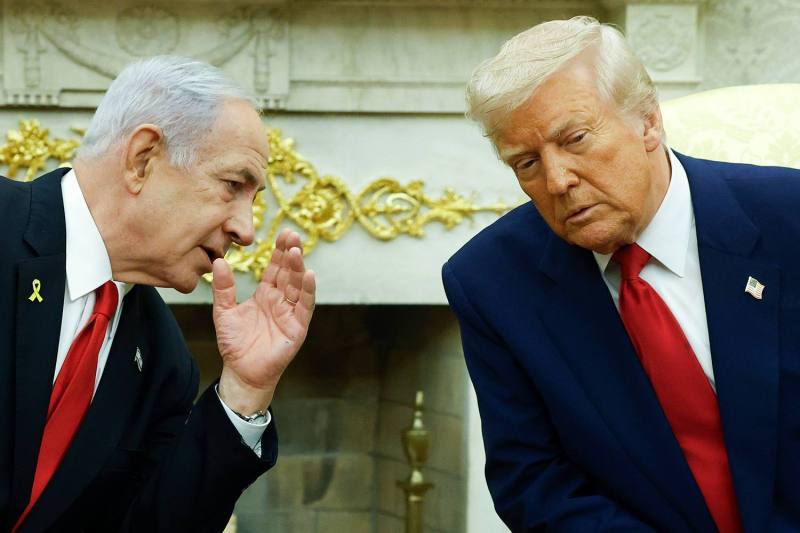What Trump Got Right in the Middle East

What Trump Got Right in the Middle East
The U.S. president’s olive branch to Iran could mark a paradigm shift in Washington’s foreign policy.
U.S. President Donald Trump leaves the Saudi royal court in Riyadh on May 13. Win McNamee/Getty Images
Sometimes, the significance of a news event can be measured by the degree to which the mainstream media downplays or ignores it altogether. This appeared to be the case this week, when U.S. President Donald Trump made comments during his trip to the Middle East that could amount to a paradigm shift in U.S. foreign policy.
Since Trump began the first overseas trip of his second term, media attention has focused on his decision to accept an ultra-luxurious Boeing 747 from Qatar to replace his old Air Force One—which critics widely derided as a breathtaking sign of corruption—and his surprise meeting with Syria’s new president, Ahmed al-Sharaa, following an announcement that Washington would lift its long-standing economic sanctions on Damascus.
Sometimes, the significance of a news event can be measured by the degree to which the mainstream media downplays or ignores it altogether. This appeared to be the case this week, when U.S. President Donald Trump made comments during his trip to the Middle East that could amount to a paradigm shift in U.S. foreign policy.
Since Trump began the first overseas trip of his second term, media attention has focused on his decision to accept an ultra-luxurious Boeing 747 from Qatar to replace his old Air Force One—which critics widely derided as a breathtaking sign of corruption—and his surprise meeting with Syria’s new president, Ahmed al-Sharaa, following an announcement that Washington would lift its long-standing economic sanctions on Damascus.
Both of these topics are worthy of serious attention. But as Trump traveled from one wealthy Arab country to another, U.S. news outlets—with a few exceptions—devoted comparatively few words to something that has profound geopolitical implications for the Middle East and beyond: Trump’s decision to extend an olive branch to Iran.
On Tuesday, Trump expressed his determination to engage directly with Iran, a country that the United States has treated as an implacable enemy for four decades. “As I have shown repeatedly, I am willing to end past conflicts and forge new partnerships for a better and more stable world, even if our differences may be profound,” Trump said during a speech in Riyadh.
Few foreign-policy convictions in Washington run so deeply as the idea of a lockstep alliance with Israel—and, by extension, the need to encourage regional powers in the Middle East to help contain Israel’s archenemy, Iran. Many analysts whose careers have been built, at least in part, on this strategy may therefore hope or believe that after his trip, Trump will abandon his overture to Tehran in a fit of forgetfulness or that Iran might do something provocative that forces the White House to change its mind.
As his tariff-based economic policy attests, Trump is not exactly known for consistency, so it is not foolish to think that a rhetorical bid for rapprochement with Iran may be short-lived. But it would be regrettable if the United States does not seriously pursue this idea. Amid a foreign-policy record full of bizarre and often pointlessly disruptive stances—from high tariffs on allies to a proposal to turn Gaza into a luxury real estate development emptied of Palestinians, which Trump repeated on this trip while paying little attention to Israel’s catastrophically punitive military campaign there—it is one of the few ideas so far that Trump has gotten right.
Consider what all these years of U.S. hostility toward Iran, beginning with its Islamic Revolution in 1979 and the Iran hostage crisis later that year, have wrought. It is a hideous balance sheet. By supporting Iraq, for instance, the United States helped fuel the 1980-88 Iran-Iraq War, which had a death toll of between 500,000 and a million people, making it one of the deadliest conflicts of the last century.
There are no innocent actors in this history. Tehran has armed and funded militant groups such as Hezbollah in Lebanon, Hamas in Gaza, and the Houthis in Yemen, and it supported one of the world’s worst modern tyrannies: the recently overthrown Assad dynasty in Syria. Iran has also espoused the destruction of Israel.
Without making excuses for Tehran’s repugnant positions, we must ask why it came to them in the first place. Part of the answer lies in the West’s historic disrespect for Iranian sovereignty, which dates to the CIA-backed overthrow of democratically elected Prime Minister Mohammad Mosaddegh in 1953 and the establishment of a pro-Western dictatorship under Iran’s shah, Mohammad Reza Pahlavi. Not without reason, Iran has long seen Israel as a proxy for hostile U.S. and Western power.
Since the 2000s, Washington has steadily tightened economic sanctions on Iran—which it first introduced in 1979—on the basis of the country’s nuclear program. Few analysts publicly ask, though, why Iran feels the need to master nuclear technologies, refusing to consider that it may have a legitimate fear of attack or need for this ultimate means of deterrence or self-defense. While Israel is justified in feeling threatened by the possibility that Iran could soon produce a nuclear weapon, Israel itself possesses such weapons. Israel also has a long-standing pattern of attacking its neighbors, as its ongoing bombings and territorial encroachments on Syria attest.
During the 2000s, I spent half a decade covering North Korea, a country whose situation is at least partly analogous to Iran’s. Pyongyang’s repression of its own people is even more pronounced than Tehran’s, and it frequently engages in provocative and repugnant behavior overseas. North Korea also has historic reasons to feel threatened: Outside of specialists, few realize that seven decades on, the Korean War has never officially ended. And like Iran under the internationally negotiated Joint Comprehensive Plan of Action, North Korea has been offered sanctions relief in exchange for abandoning or limiting its nuclear program.
Once North Korea committed seriously to developing nuclear weapons in the 1980s, though, nothing that U.S. presidents have tried since has deterred it from this goal. Recent world history provides a host of reasons why countries such as North Korea would resist changing course. Ukraine gave up the nuclear weapons deployed on its soil during the Soviet era only to see Russia invade it decades later. Libya’s dictator, Muammar al-Qaddafi, voluntarily ended his illegal chemical weapons programs only to have Western countries back his overthrow and eventual assassination. Libya today is a failed state whose violence and flood of trafficked arms have destabilized much of Sahelian Africa.
Trump’s approach to North Korea during his first term suggests a logic behind his recent language toward Iran. He engaged in high-level, personal diplomacy with leader Kim Jong Un and sought to lessen bilateral tensions to defuse a potentially catastrophic geopolitical situation. As with much else that he does, Trump’s diplomacy at the time was erratic and poorly planned. It also failed to fundamentally change anything on the Korean Peninsula.
That does not necessarily invalidate the truth underlying Trump’s actions: Sometimes the only way to avoid endless armament and the likelihood of future catastrophe is by engaging with a longtime enemy and finding ways to build mutual confidence and guarantees of security. That cannot be achieved in haste.
Even to contemplate doing so with Iran will be a hard pill to swallow for many in Washington and will appear inconceivable to the Israeli government. Israel not only regards Iran as an existential threat because of its nuclear weapons potential; Iran’s existence as a seemingly permanent enemy of the United States has long served as a powerful rationale for the latter’s steadfast political support for—and constant heavy armament of—Israel. On Thursday, Trump claimed that the United States and Iran have “sort of” agreed on the terms of a nuclear deal, but the details remain unknown, and it is unclear how this will play out.
Elsewhere, though, the ground seems to be shifting. Even before Trump’s trip, Saudi Arabia and other traditional rivals of Iran in the region started to signal their desire to de-escalate tensions with Tehran. These developments have likely grown out of a conviction that a policy of belligerent containment of Iran is a dead end. Regional powers are coming to see that decades of war have squandered both the Middle East’s great resource wealth and its human potential. To end this historical cycle, Iran—a country of 90 million people and the world’s 19th-largest economy—must be brought in from the cold and a new, positive-sum dynamic established between Tehran, the Arab nations, and Israel.
We are, of course, a long way away from realizing this, and Trump, with his many shortcomings and idiosyncrasies, may never deliver. But in order for something to change, a topic must be raised and put on the agenda. That may be the most important legacy of Trump’s trip to the Middle East.
This post is part of FP’s ongoing coverage of the Trump administration. Follow along here.
Howard W. French is a columnist at Foreign Policy, a professor at the Columbia University Graduate School of Journalism, and a longtime foreign correspondent. His latest book is Born in Blackness: Africa, Africans and the Making of the Modern World, 1471 to the Second World War. Bluesky: @hofrench.bsky.social X: @hofrench
More from Foreign Policy
-

Indian Air Force personnel stand in front of a Rafale fighter jet during a military aviation exhibition at the Yelahanka Air Force Station in Bengaluru. A Tale of Four Fighter Jets
The aircraft India and Pakistan use to strike each other tell a story of key geopolitical shifts.
-

A cardinal in a black robe with red sash with hands folded in front of him walks past a stage and steps. Conclave Sends Message With American Pope
Some cardinals had been agitating for U.S. leadership to counter Trump.
-

An illustration shows red tape lines crossing over and entrapping a semiconductor chip. Is It Too Late to Slow China’s AI Development?
The U.S. has been trying to keep its technological lead through export restrictions, but China is closing the gap.
-

A man watches a news program about Chinese military drills surrounding Taiwan, on a giant screen outside a shopping mall in Beijing on Oct. 14, 2024. The Pentagon Fixates on War Over Taiwan
While U.S. military leaders fret about China, Trump has dismissed the Asia-Pacific.












Join the Conversation
Commenting on this and other recent articles is just one benefit of a Foreign Policy subscription.
Already a subscriber?
.
Subscribe
Subscribe
View Comments
Join the Conversation
Join the conversation on this and other recent Foreign Policy articles when you subscribe now.
Subscribe
Subscribe
Not your account?
View Comments
Join the Conversation
Please follow our comment guidelines, stay on topic, and be civil, courteous, and respectful of others’ beliefs.
Change your username |
Log out
Change your username:
CANCEL
Confirm your username to get started.
The default username below has been generated using the first name and last initial on your FP subscriber account. Usernames may be updated at any time and must not contain inappropriate or offensive language.